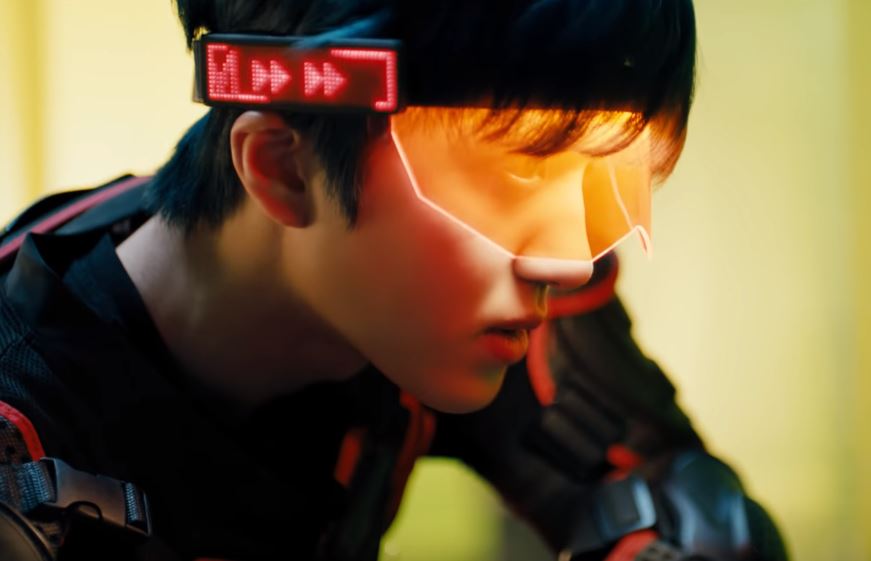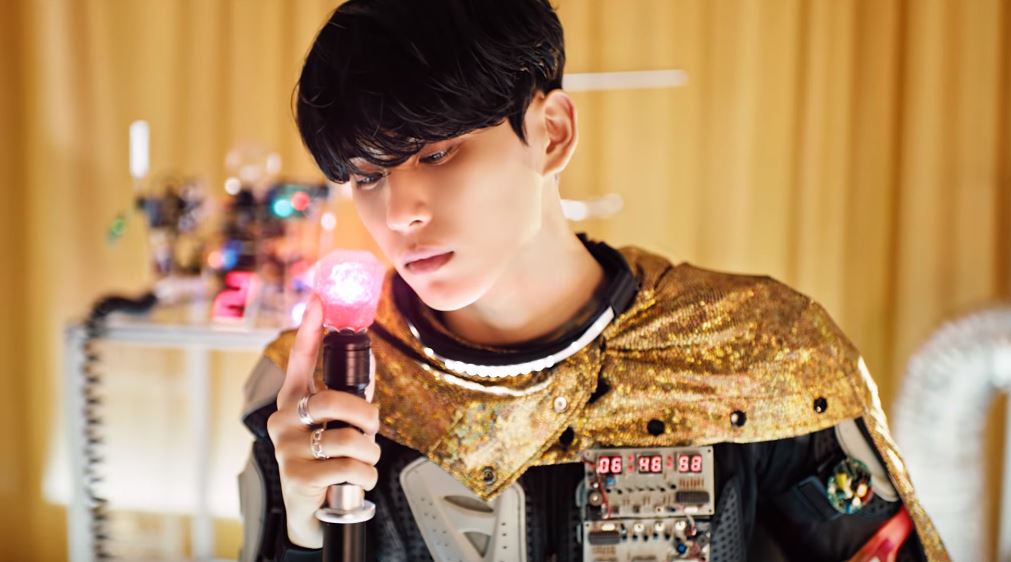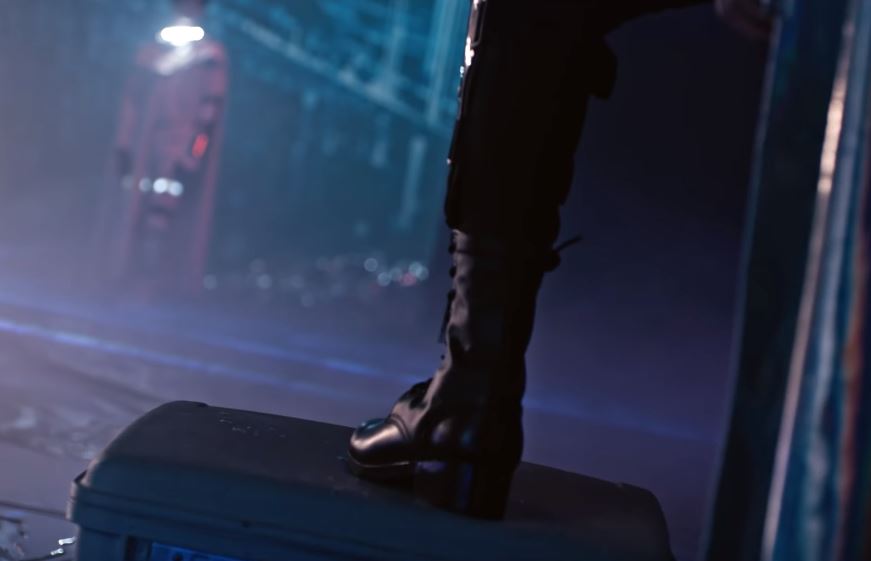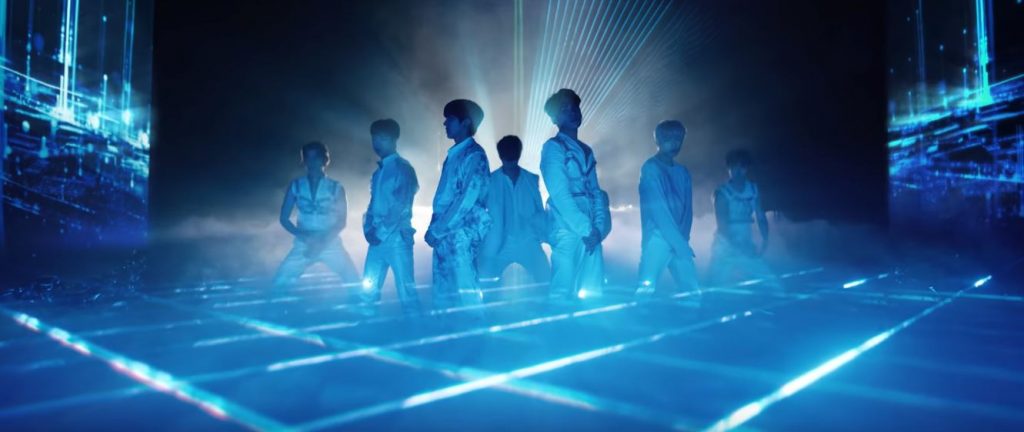
Just a few months after the release of “Enough,” SF9 is back again with the futuristic “RPM.” The comeback had been teased during their recent world tour, and will certainly add some freshness to their upcoming performance at Kcon NY in July.
Known for experimenting with a variety of styles, the group adds yet another versatile example to their discography with this release. Produced by Tha Aristocrats, Maxx Song, Tyon “TC” Mack, Moon Kim and Tesung Kim, the track builds upon a rough guitar riff and expands in rich, layered synths. Right at the start, Tha Aristocrats’ tag “come in” immediately reminds us of EXO’s “Overdose.” The 2014 hit could well be “RPM’”s long lost cousin if only the latter didn’t fall prey to a disgruntled fad of 2019: that’s right, the unnecessary instrumental drop.
In fact, this drop is so out of place with the rest of the song that it feels like it was a later addition per request of FNC Entertainment, in order to make the song more trendy. However, this stylistic choice only makes it harder for SF9 to stand out, as it couldn’t be more ubiquitous in the oversaturated boy group landscape. Fortunately, the drop is followed by an actual chorus, and the driving melancholy of it is catchy enough to keep the track afloat. Paired with stellar rap lines by Youngbin, Hwiyoung and Zuho — who are credited as lyricists alongside Han Seong-ho — “RPM” also brings back a certain “Easy Love” vibe, and that is a merit of its own.
Moving on to the MV, “RPM” builds upon the track’s futuristic sounds to create its own Tron-inspired narrative. In between neon lights, clouds of smoke and nocturnal hues, SF9 are clad in black outfits with ticking clocks that suggest they don’t have much time left.

“RPM” certainly had more budget than “Enough,” as the aesthetics present a luxurious voyage to the next century, with beautiful light play and creative special effects. However, it suffers from the same lack of commitment to a storyline that was full of potential. There is a lot going on in this MV, and while it’s not necessary to give viewers a chewed-up story, cohesive hints and clues help in fostering the engagement with any entertainment media — and that’s not what happens here.
At first sight, tension is visibly the main point of “RPM.” There is an impending sense of doom in the atmosphere, enhanced by the ticking clocks, incessant running, and red lasers everywhere. Rowoon exercises his acting skills since the beginning, with convincing expressions of panic and danger. As the story develops, it’s possible to infer that the members are split into teams, and their ultimate goal is to obtain pink crystals that are locked inside a white room. While it’s never clear what exactly the crystals do, it’s likely that they halt the countdown in their outfits, give them freedom, or any similar power.
Taeyang seems to be some kind of leader, as his golden cloak and technological background contrast with the dominant silver and blue hues of the rest of the MV. He holds a staff with a pink crystal perched on top and stands fearless even though his clock dangerously counts down.

Youngbin seems connected to Taeyang, as he plays a solo agent who manages to capture one of the pink crystals in the white room. After adding it to a circuit board inside of a suitcase, Taeyang’s staff lightens up, his clock reaches zero, and he throws the golden cloak away, possibly hinting at an escape.
Teammates Dawon, Inseong, Hwiyoung and Jaeyoon aren’t so lucky. Even though they manage to enter the crystal room, the security alarm goes off as soon as they touch them. While the quartet attempts to escape by running, Jaeyoon reveals himself to be a double agent by stopping and shooting a flare gun, therefore helping whoever might be after them.
Chani runs in circles with special “RPM” glasses. His outfit flashes the words “training mode” (observable in the Making Film video), but what is he training for? Whether it’s to generate energy for the crystals and clocks, or to plan an escape, there is no clue to its purpose. At some point, Chani gives up on the running and falls down to the floor, removing his glasses and disappearing from the rest of the narrative.
And then there’s Zuho. His clock counting goes upwards, contrary to the others. If he is some kind of leader, like Taeyang, remains unclear, but he does seem to have some upper power over the other members. Like Chani, he is seen running in circles but looks disappointed when he finds out the maknae left his glasses behind and is nowhere to be seen.

Towards the end of the MV, Youngbin throws the suitcase with the crystal under the rain, and a mysterious cloaked figure catches it. Based on the outfit and solo scenes, the figure is presumably Rowoon, but what is his role in the rest of the story is an even bigger mystery to solve.
There are many assumptions to be made, as the MV doesn’t offer any satisfactory links for a cohesive storyline to develop. Cliffhangers can be exciting and lead to interesting interpretations, but in “RPM” they just bring frustration. There are way too many possibilities, and even choosing a more general approach means ignoring parts that don’t fit, and thus cutting short the full enjoyment of this release.
All of this leads to an unpleasant, but undeniable comparison. While not a direct copy per se, “RPM” seems heavily inspired by EXO’s narrative, most specifically by the MVs of “Tempo” and “Lucky One.” For those who don’t follow SM Entertainment’s group, it’s fandom knowledge that EXO is constantly fighting against a mystic Red Force that appears in almost all of their MVs. “Tempo” and “Lucky One” display that battle through red lasers and lights, just like SF9 did in “RPM”. Both EXO MVs have futuristic themes, and “Tempo” also bears a similarity to Tron, as well as a ticking clock on one wall. In “RPM,” instead of the white hospice attire of “Lucky One,” there are white suits and cloaks. And instead of “Tempo’”s motorcycles, cubes and helmets, there is running, crystals, and the very own speed concept.

While in Exoplanet all of these choices made sense, as they linked with elements of the group’s universe since debut, in SF9’s case they seem rather thrown out at random. “RPM” has some similarity to their 2017 single “Easy Love,” but nothing that forges a deeper connection — which could have been an interesting step.
It seems like the less SF9 bothers with narratives, the more successful in delivering a message they become. “Easy Love” and “Now or Never,” for example, had their own aesthetic themes but weren’t focused on making a story out of them — and yet remain their most remarkable eras. Even the odd mystique of “O Sole Mio” was highly suggestive, yet abstract enough to not leave viewers in need of some meaning.
“RPM” is surely astonishing, and the quality of its production is indisputable. As always, SF9 delivers breathtaking visuals, choreographies, raps, and vocals (once again, props to Inseong and his shiver-inducing high notes), but the overall product misses their potential. Instead of bumping up the RPM and sprinting ahead of the industry, FNC Entertainment seems to want SF9 circling around, never daring enough to escape the cycle. It’s not for lack of skills or resources, so hopefully, a change will come with time.
(Youtube. Images via FNC Entertainment.)



